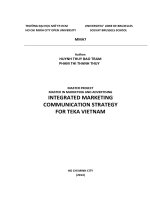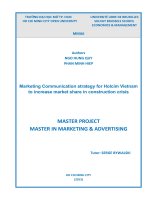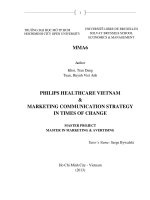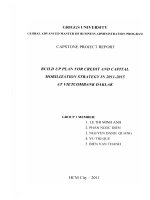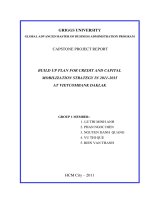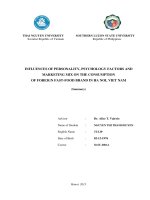Philips healthcare Vietnam and marketing communication strategy in times of change
Bạn đang xem bản rút gọn của tài liệu. Xem và tải ngay bản đầy đủ của tài liệu tại đây (1.28 MB, 59 trang )
1
TRNG I HC M TP.HCM
HOCHIMINH CITY OPEN UNIVERSITY
MMA6
Author
Khoi, Tran Dang
Tuan, Huynh Viet Anh
PHILIPS HEALTHCARE VIETNAM
&
MARKETING COMMUNICATION STRATEGY
IN TIMES OF CHANGE
MASTER PROJECT
MASTER IN MARKETING & AVERTISING
Tutor’s Name: Serge Bywalski
Ho Chi Minh City - Vietnam
(2013)
UNIVERSITEÙ LIBRE DE BRUXELLES
SOLVAY BRUSSELS SCHOOL
ECONOMICS & MANAGEMENT
2
“Trade in health services will be affected by changes in general trade
liberalization, international legislation, and international institutions; in return,
it will itself impact on national economies”.
(Blouin & Drager & Smith, 2005 – World Bank)
3
Acknowledgements
Over the time conducting the study and writing the paper, we have encountered certain
difficulties, which should have certainly caused obstacles for us in accomplishing this
project if we had not received great supports. Therefore, we would like to dedicate our
acknowledgement to those who have offered us valuable helps during the dissertation
working process.
First of all, we would like to express our gratitude to the all people who have
contributed to this thesis and supported us.
We would like to give a special thank to our tutor Serge Bywalski for his patience with
our questions and for giving us a valuable feedback.
We would like to offer our true thanks to our friend, Mr. Ng, Kenneth - Manager
Business Intelligence, ClusterAPAC Marketing and Mr. Truong, Quoc Dung - SMIS
Manager, SMIS Vietnam who is working at Philips Vietnam for giving us significant
information of PHC Vietnam which we have been unable to search in other data
sources.
Last, but not least, we want to thank our friends and families for their support. We
would never finish this thesis without these people.
4
Executive Summary
Nowadays, one of the most challenging factors for a company to develop is future
planning because the environment is changing rapidly which forces the company to
deal with change almost every day. The companies and theirs Board of Directors,
therefore, need to have the ability to manage their current business as well as to handle
unexpected changes.
Established since 2002, Philips has had an increasingly large focus on Vietnam and
Philips Healthcare (PHC) is very successful in Vietnam as one of the market leader.
2011 was started with worries of local team due to economy downtrend. However, by
year end, the market of PHC keeps on good growth.
But, there are early signs of market problem in Vietnam. The market is still on the
upward trend but with the global recession, there will be many changes in the
economy, social policies of the Vietnam government in 2012. Healthcare is one of the
sectors that suffer a lot from these changes. Vietnam faces pressures with budget
constraints, ageing populations and growing disease of prosperity such as obesity and
diabetes. In addition, many of the regions are emergent and lacking essential healthcare
skills and infrastructures, creating an urgent need for reform. The investment in
healthcare is huge and new market participants are staking their claims by introducing
new business models that are changing the competitive landscape.
The purpose of this study is to provide a general view about PHC Vietnam in the
market, to evaluate the marketing activities of the company in the previous years and
how the company should communicate with customers during times of change.
All things considered, we believe that we have provided PHC Vietnam a roadmap
which suggests a good plan for the future to make PHC Vietnam become the market
leader in term of market share in the next 5 years.
5
Table of Contents
Acknowledgements 3
Executive Summary 4
Table of Figures 8
List of Abbreviations 9
CHAPTER 1 – INTRODUCTION 10
1.1. Company’s background 10
1.1.1. Philips Global 10
1.1.2. Philips Vietnam 11
1.2. Time of recession/time of change 12
1.3. Problem discussion 14
1.3.1. Active strategy 14
1.3.2. Or passive strategy 14
1.4. Project objective 14
1.5. Research methodology 14
1.6. Scope and limitation 14
1.7. Outline of the study 15
CHAPTER II - SITUATION ANALYSIS 16
2.1. Market overview and business situation 16
2.1.1. Vietnam 16
2.1.2. Healthcare Indicators of Vietnam 16
2.1.3. Health Care Delivery System 17
2.1.4. Medical Device Market Size 17
2.1.5. Specifics on the local healthcare market 18
2.2. Situation analysis 19
2.2.1. Macro Environment analysis 19
2.2.2. SWOT analysis 21
2.2.3. Competitor analysis 23
2.2.4. Customer analysis 25
CHAPTER III - MARKETING COMMUNICATION IN THE PAST 33
3.1. Past marketing communication campaigns 33
6
3.1.1. The Annual MR & CT end-users meeting (on October) 33
3.1.2. Vietnam Annual Radiology Association Conference (on April) & Customer Service
Workshop (on September) 34
3.1.3. Marketing focus to community 34
3.1.3.1. Simply Healthy @ School Program (SHS) 34
3.1.3.2. World Heart Day Vietnam: once/year 35
3.1.4. Others: 36
3.2. Evaluations of the past campaigns 36
3.2.1. The annual MR & CT end-user meeting 36
3.2.2. Vietnam annual Radiology Association Conference & Customer service workshop 36
3.2.3. Marketing focus to community (CSR) 37
3.3. Summary 37
3.4. Recommendations for the times of change 38
3.4.1. Strategy 38
3.4.2. Conclusion 39
CHAPTER IV - MARKETING COMMUNICATION STRATEGY IN TIMES OF CHANGE 42
4.1. Brand strategy 42
4.1.1. Vision 42
4.1.2. Mission 42
4.1.3. Target customer 42
4.1.4. Positioning and pricing strategy 42
4.1.5. Customer insights 42
4.2. KPIs 43
4.2.1. Business objective 43
4.2.2. Marketing objective 43
4.3. Marketing communication 43
4.3.1. Campaign idea 43
4.3.2. Key visual 44
4.3.3. Communication strategy 45
4.3.3.1. Project 1 – Boosting the brand (new concept) 45
4.3.3.2. Project 2 – Events (keep from the past campaign) 46
7
4.3.3.2.1. The Annual MR & CT end-users meeting 46
4.3.3.2.2. Vietnam Annual Radiology Association Conference & Customer Service Workshop 47
4.3.3.3. Project 3 – CSR (new concept modified from the past campaign) 48
4.3.3.3.1. Activity 1: Community health check for remote area 48
4.3.3.3.2. Activity 2: World Heart Day Vietnam 49
4.3.3.4. Project 4 – Philips healthcare online Center (new concept) 49
4.3.3.5. Other projects 50
4.3.3.6. Choosing the right media 50
4.4. Action plan 53
4.5. Budget 54
Appendix A 55
Questionnaires for the market research 55
Appendix B 57
PPP Projects in Vietnam Basic Understanding, Implementation and Challenges 57
References 59
8
Table of Figures
Figure 1 - Philip Healthcare’s products family (Source: Philips Global) 11
Figure 2 - Philip Healthcare Vietnam’s products family (Source: Philips Vietnam) 12
Figure 3 – Vietnam economy indexes (Source: TNS Vietnam) 13
Figure 4 – Vietnam healthcare indicators (Source: Frost and Sullivan analysis) 16
Figure 5 – Vietnam healthcare delivery system (Source: Vietnam Ministry of Health;
Frost and Sullivan analysis) 17
Figure 6 – Medical device market (Source: Espicom) 18
Figure 7 – Competitors map (Source: Frost and Sullivan analysis) 23
Figure 8 – Revenue of PHC Vietnam (Source: Philips Vietnam) 26
Figure 9 – Market research (drivers for promotion) (Source: Philips Vietnam) 29
Figure 10 - Market research (causes for detraction) (Source: Philips Vietnam) 30
Figure 11 – Competitors (Source: Philips Vietnam) 31
Figure 12 - Competitive NPS Performance (Source: Philips Vietnam) 31
9
List of Abbreviations
ANGIO: Angiography
AOP: Annual Operation Plan
CEO: Chief Executive Officer
CME: Continuing Medical Education
CR: Computed Radiology (equipment)
CSA: Customer Support Agreements
CT: Computed Tomography (equipment)
CV: Cardio Vascular (equipment)
DR: Digital Radiology (equipment)
DSA: Digital Subtraction Angiography (equipment)
ENT: Ear Nose and Throat specialist
EU: European Union
FDA: US Food and Drug Administration
FMCGs: Fast Moving Consumer Goods
GMP: Good Manufacturing Practices certification
KOLs: Key of Leaders
HCMC: Ho Chi Minh City
HIS: Hospital Informatics System
IMS: International Medical Statistics
MOH: Ministry of Health
MR: Magnetic Resonance (equipment)
MR: Medical Representative
ODA: Official Development Assistant
OIT: Order in take
OTC: Over the Counter
PACS: Picture Achieving Communication System
OOH Order on hand
CVD Cardio Vascular Disease
PO: Purchase Order
Rep. Office: Representative Office of Pharmaceutical
R&D: Research and Development
RIS: Radiology Informatics System
SOP: Standard of Procedure
SWOT: Strengths Weaknesses Opportunities and Threats
US: Ultrasound (equipment)
WTO: World Trade Organization
10
1. CHAPTER 1 – INTRODUCTION
1.1. Company’s background
1.1.1. Philips Global
Royal Philips Electronics of the Netherlands is a diversified Health and Well-being
company, focused on improving people’s lives through meaningful innovations. As a
world leader in healthcare, Philips integrates technologies and design into people-
centric solutions, based on fundamental customer insights and the brand promise of
“sense and simplicity”.
Headquartered in the Netherlands, Philips employs over 122,000 employees with sales
and services in more than 100 countries worldwide. With sales of EUR 22.6 billion in
2011, the company is a market leader in cardiac care, acute care and home healthcare,
energy efficient lighting solutions and new lighting applications, as well as lifestyle
products for personal well-being and pleasure with strong leadership positions in male
shaving and grooming, portable entertainment and oral healthcare. Philips is a global
leader across its healthcare, lighting and lifestyle
Philips simplifies healthcare by focusing on the people in the care cycle – patients and
care providers. Through combining human insights and clinical expertise, Philips aim
to improve patient outcomes while lowering the burden on the healthcare system.
Advanced healthcare solutions are a fundamental part of the portfolio for both
healthcare professionals and consumers, to meet the needs of patients in hospitals and
at home. Philips Healthcare employs approximately 35,500 people worldwide. In 2011
the Healthcare business accounted for approximately 40 percent of Philips’ overall
sales, the company’s largest contributor to sales.
Facts and Figures
. €8.9 billion sales in 2011
. 37,000+ people employed worldwide in 100 countries
. 8 % of sales invested in research and development in 2011
. 450+ products and services offered in more than 100 countries
11
Philip Healthcare’s product:
Pharmaceuticals and Biotechnology
Medical Devices
Medical Imaging
Healthcare IT
1. Philips Global
1.1.2. Philips Vietnam
Following the renovation of Vietnam’s economic system, which began in 1986, Philips
has had an increasingly large focus on Vietnam. Philips was one of the first foreign
companies to establish its presence in Vietnam. From 1992, Philips’ business in
Vietnam was managed from Singapore with Distributors in Vietnam. Following that,
as a Representative Office for Philips Electronics Singapore, Philips Healthcare began
its direct expansion in Vietnam. Philips Electronics Vietnam, Ltd. was established in
2002.
Figure 1 - Philip Healthcare’s products family (Source: Philips Global)
12
The Healthcare team expanded greatly in the second half of 2009, in anticipation of
implementing the SAP ERP M4 system (December 2009 to January 2010). Currently,
Philips Healthcare Vietnam is part of Philips Electronics Vietnam, Ltd., and is licensed
to do business directly in country, able to do importation and direct sales to both
Distributors and End-users.
Philips Healthcares has worked with several modern hospitals in Vietnam that are
focused on providing the best quality care and patient outcomes by leveraging
advanced medical technology.
Philips is recognized as a market leader in Cardio-Vascular X-Ray, CT, mid-range
Shared Service Ultrasound, and Patient Monitoring (acute, sub-acute and maternal-
fetal).
1.2. Time of recession/time of change
The global recession has hurt Vietnam's export-oriented economy, with GDP in 2009-
2011 growing less than the 7% per annum average achieved during the last decade. In
2011, exports increased by more than 33%, year-on-year, and the trade deficit, while
Figure 2 - Philip Healthcare Vietnam’s products family
(Source: Philips Vietnam)
13
reduced from 2010, remained high, prompting the government to maintain
administrative trade measures to limit the trade deficit.
In early 2012 Vietnam unveiled a broad "three pillar" economic reform program,
proposing the restructuring of public investment, state-owned enterprises and the
banking sector. Vietnam's economy continues to face challenges from low foreign
exchange reserves, an undercapitalized banking sector, and high borrowing costs. The
near-bankruptcy and subsequent default of the state-owned-enterprise Vinashin, a
leading shipbuilder, led to a ratings downgrade of Vietnam's sovereign debt,
exacerbating Vietnam's borrowing difficulties.
The State Bank of Vietnam reported that as the end of March - 2012, Vietnam's bad
debts ratio amounted US $9.6 billion U.S = 8.6% total outstanding credit.
Fitch Ratings and other independent economic survey organizations estimate = 14% or
13.3 billion U.S. dollars.
Vietnam’s 100 largest state enterprises are indebted about US $50 billion, or more than
one third of GDP.
Figure 3 – Vietnam economy indexes (Source: TNS Vietnam)
14
1.3. Problem discussion
Due to the above situation, PHC faces with many questions in the business and
marketing strategy for the next coming years.
1.3.1. Active strategy
Stuck to the values by continued investment marketing which enabled speedier
recoveries
Took advantage to strengthen against weaker rivals
1.3.2. Or passive strategy
Cost cutting
Price promos
1.4. Project objective
To analyze the company’s situation and find the best strategy in time of recession
To understand target customer’s needs and find their key buying triggers in the next
coming years
To make an appropriate marketing communication for the next coming years to meet
with the business objective within the available budget
1.5. Research methodology
Relevant desk researches and secondary information are used for the analysis.
A qualitative research (In-depth interview) is conducted to key persons who can
influence the buying decision to know more about the health of the brand and assist for
the marketing decision
1.6. Scope and limitation
This study is made on December 2012 and January 2013. Some information from desk
researches is not up-to-date and result from qualitative research might not be as
accurate at the time it reaches professors.
The market research is conducted for markets with low sample size. As a result,
interpreting the results is carried out under caution.
15
1.7. Outline of the study
The study is organized with 4 chapters
CHAPTER I - INTRODUCTION
The aim of this chapter is to present the background of the subject. It starts with an
overview of the company, followed by an introduction about Healthcare Industry of
Vietnam, This is followed by a problem discussion, which will lead to our research
question and finally the purpose of the thesis is presented: how to do the marketing in
times of change
CHAPTER II - SITUATION ANALYSIS
In this chapter we will combine our theory with what happened in the market in order
to figure out how PHC Vietnam influenced from both internal and external factors,
including:
Macro Environment Analysis: using PESTEL as a tool to find out the external factors
that affect the market which many desk researches is taken into account
SWOT Analysis: to identify PHC Vietnam’s advantages as well as drawbacks and
threats in times of change
Competitor Analysis: to identify PHC Vietnam’s competitors: Who are they? What
are their market positions, shares, advantages and weakness?
Customer Analysis: to get a deeper understand of PHC Vietnam’s customers
CHAPTER III - MARKETING COMMUNICATION IN THE PAST
This chapter is to review, evaluate the past campaigns to recommend new campaigns in
times of change
CHAPTER IV - MARKETING COMMUNICATION IN TIMES OF CHANGE
This chapter provides the marketing communication in times of change. Target for
2013, action plan, budget, timeline and KPIs for evaluation are also covered in this
chapter.
16
2. CHAPTER II - SITUATION ANALYSIS
2.1. Market overview and business situation
2.1.1. Vietnam
A Southeastern Asian country, bordering the Gulf of Thailand, Gulf of Tonkin, and
South China Sea, as well as China, Laos, and Cambodia. There are 64 cities and
provinces. In the south, the Mekong River is a prominent feature. Much of the country
is mountainous and hilly.
A population of 91.5 million (July, 2012) and growth rate of 1.1 percent in 2011, as
well as urbanization rate to grow about 3.3 percent annually, reaching an urban
population of 30 million in 2014. Hence, Vietnam emerges as a populous and young
nation with rapid urbanization.
(Source: Vietnam General Statistic Office)
2.1.2. Healthcare Indicators of Vietnam
Vietnam represents a potentially huge medical device market, with a population of 89
million and a steady GDP growth of 7 percent annually. In 2012, the market for
medical equipment is worth USD $600 Million and is growing by 15 percent each year.
Since local production is small, the market relies entirely on imports.
Figure 4 – Vietnam healthcare indicators
(Source: Frost and Sullivan analysis)
17
2.1.3. Health Care Delivery System
Healthcare services in Vietnam are dominated by the public sector and as of 2009,
approximately 93.0 percent of hospitals were public. Public sector offers healthcare
services through four tiers: commune, district, provincial, and central. The Ministry of
Health (MOH), which is part of the central tier, handles health policies and
administration.
\
2.1.4. Medical Device Market Size
The Vietnamese medical device market is likely to expand in the future as more
products are imported to meet the requirements of new and existing healthcare
facilities. A number of hospitals have opened in recent years, and with the government
keen to develop its healthcare system, imports are expected to continue growing
rapidly.
Figure 5 – Vietnam healthcare delivery system
(Source: Vietnam Ministry of Health; Frost and Sullivan analysis)
18
The most recent initiative by the government that will foster medical device market
growth is the 45.2 trillion dong (US$2.5 billion) pledged to build or upgrade specialty
hospitals and some provincial-level general hospitals in mountainous and other
disadvantaged areas in the 2009-2013 period.
As Vietnamese manufacturers tend to produce only basic medical items such as
syringes and needles, the more complex equipment required will continue to be
sourced from overseas companies. Imports have more than doubled over the 2005-
2009 period.
The medical device market is expected to expand at very strong CAGR of 15.2%,
which should see the market grow from an estimated US$599.2 million in 2011 to
US$1,213.9 million in 2016.
2.1.5. Specifics on the local healthcare market
Distribution
Only local companies can distribute medical devices in Vietnam – foreign companies
must therefore sell their products through appointed local distributors and agents.
Legalities aside, Vietnamese buyers, especially in the public sector, generally expect to
deal with a local distributor to handle all aspects of distribution, from delivery to after
sales services and provision of spare parts.
Medical device regulations
Vietnam has no specific system of device regulation. However, the MOH issues an
annual list of equipment which must be registered before it can be imported. This list
Figure 6 – Medical device market (Source: Espicom)
19
mainly comprises expensive diagnostic apparatus, products involving blood or
sterilization, and emergency equipment. The registration process is reportedly quick.
Devices with major international approvals should have little problem.
Vietnam is heavily reliant on imports and lacks the capacity to make import
substitution policies worthwhile
2.2. Situation analysis
2.2.1. Macro Environment analysis
Political factors
The Communist Party government appears committed to market-oriented reforms,
although specific economic policies will undoubtedly be discussed at the 2011 National
Congress. The one-party system is generally conducive to short-term political stability
The government recognizes the threat that corruption poses to its legitimacy, and has
acted to clamp down on graft among party officials. Vietnam has allowed legislators to
become more vocal in criticizing government policies. This is opening up advantages
for more checks and balances within the one-party system.
The current reform of public hospital organizational management, allowing greater
hospital autonomy, has led to greater advantages for accessing private resources for
hospital capital investments. However, weak regulation and control over the prices of
pharmaceutical products and medical technology services has, in addition, contributed
to overall escalation of health care costs, which remains an ongoing challenge.
Economic factors
According to the Ministry of Health, through 2015, the government has projected to
spend USD 1.8 billion for building 57 new hospitals, of which over USD 1 billion will
be spent on medical equipment. The government has set out plans to attract ODA
funding of USD 690 million or about 25 percent of the healthcare development budget
required from through 2015.
New health service facilities are expected to be charged an enterprise income tax of
10% rather than the previous 28% which will makes the private sector play a bigger
20
role in healthcare delivery in Vietnam, private public partnerships (PPPs) are
increasing as governments seek to build greater capacity. (Source: Vietnam General
Statistic Office)
Social factors
The size of the private healthcare sector in Vietnam is expanding, especially in the
urban areas of the country. The availability of private clinics and surgeries has
improved significantly, particularly in urban areas, since the lifting of the ban on
private practice in 1989. According to the WHO, the bulk of healthcare expenditure
came from private sources, with the public sector spending just 44.6% of the annual
total.
The growth of new public and private hospitals and expansion/upgrading of existing
hospitals under government healthcare development initiatives will translate into more
tender projects for medical devices. The emergence of private doctors and hospitals
within the past 10 years has begun to expose Vietnamese hospitals to market pressure,
thereby boosting the demand to improve the quality of the facilities, equipments and
technology to remain competitive.
Technology factors
All the equipments in healthcare industry are brand-new with latest technology. The
import of used-equipments is prohibited by government.
The quality of human resource in healthcare industry of Vietnam is still low. The
shortage of high-tech technician in many remote provinces is still a hard puzzle for
Vietnam government.
Legal factors
The economic recession has caused bankruptcies, closed operations and increased tax
debts. The International Monetary Fund in its recently released report on world
economic prospects praises Vietnam’s achievements since the launch of the
government’s resolution on controlling inflation, stabilizing the macro economy, and
ensuring social security. With the world economy mired in recession and debts crises
in the US and Europe, Vietnam is determined to pursue a tight monetary policy and
flexible solutions to achieve targets set for this year and the years to come.
21
In the face of these challenges, the Vietnamese government issued the resolution No
11 to control inflation, stabilize the macro economy, and ensure social security.
Recently, the State Bank of Vietnam has put in place a number of measures to regulate
the forex market and contain inflation. The recent reduction of interest rates has helped
reduce the public’s concern over high inflation and stabilize the Vietnamese dong.
2.2.2. SWOT analysis
Strengths
Philips Healthcare Vietnam has been supporting the Ministry of Health of Vietnam in
the process of ASEAN medical device regulatory harmonization.
Brand name: PHC is a top name in healthcare product with product reliability and
durability. Philips is recognized as a market leader in Cardio-Vascular X-Ray, CT,
mid-range Shared Service Ultrasound, and Patient Monitoring (acute, sub-acute and
maternal-fetal), with highly competitive Products in MRI, Cardiac Ultrasound,
Ventilation (Philips-Respironics) and Cardiac Resuscitation.
Distribution system: maintain two strong distribution channels - Authorized Distributor
and Spot Dealer
PHC has a strong partnership with most of the leading medical training
centers/hospitals in Vietnam, such as HCMC Medicine and Pharmacy University,
DaNang General Hospital, Hue Central Hospital, Bach Mai Hospital, Viet Duc
Hospital; the partnership include:
. On-site training by Philips experts and PHC’s products: Ultra-sound, CT, MR, Cardio
Vascular…
. System demonstration for new product that enable doctors to experience latest
technology in healthcare
Weaknesses
PHC is well-known for unbeatable technology but super expensive worldwide. In the
other hand, Siemen - with OEM products from China - is following competition
pricing strategy: for each of the product launch, they are targeting in attack a certain
model of PHC and setting the price 30 to 40 percent lower.
22
Maintenance service is one of a big problem of PHC. The spare-part price and labor
cost are rather high compare to other competitors. Duration for spare-part warranty is
very short, only one month
Sales team is not good enough for the market. Besides, PHC’s policy in sale is: “No
incentive for buyer” which makes it harder for the team
Opportunities
Vietnam represents a potentially huge medical device market, with a population of 90
million and the trend for high-tech treatment is growing by significantly each year
Vietnam’s healthcare expenditure will grow over the next five years with its healthcare
spending as a percent of GDP surpassing most ASEAN countries and growing up to
8.3 % of the GDP in 2014
Public Healthcare sector is one of the high priority sectors in investment of Vietnam
government. The government also aims to modernize traditional medicine by 2020.
According to MOH, hospitals that offer traditional alternatives to patients will receive
new equipment in 2015
The government introduced the Public Private Partnership (PPP) investment model
which can play a prominent role in bringing skills, access to capital, and wider
efficiencies to healthcare delivery (the Decision No. 71/2010/QD-TTg of Prime
Minister).
Threats
Siemen are more and more aggressive in developing and promoting their equipments
with lower price and better service.
Resolution No 11 to control inflation, stabilize the macro economy, and ensure social
security of the government may affect to the investment of public healthcare sector.
Vietnam economy is affected badly with the global economy downtrend, which can
make the healthcare market is more vulnerable to the rising of the global market.
23
2.2.3. Competitor analysis
Over 95% of the market is made up of foreign goods. The main sources are the US,
Germany and Japan, with Taiwan, Italy, France and South Korea also accounting for
significant shares. Local production is extremely limited in terms of value, but volume
levels suggest the foundation for ascent up the value chain.
Direct competitor
Siemens is the market leader in term of market share of Vietnam’s the healthcare
market. Siemens opened Representative Offices in Hanoi and Ho Chi Minh City in
1993 and supplied the first two Magnetic Resonance Systems in 1996. Siemens has
successfully installed and operated the Biograph 64 PET.CT and Cyclotron systems at
Cho Ray Hospital in Ho Chi Minh City in early 2009. Until now, a broad spectrum of
Siemens advanced diagnostics products and solutions was demonstrated at the
marketplace which exhibited over 12 stations showcasing solutions ranging from
Figure 7 – Competitors map (Source: Frost and Sullivan analysis)
24
immunology, chemistry, integrated system, automation, IT solutions, hematology,
plasma protein, blood gas, diabetes, urinalysis, microbiology to molecular. Especially,
Siemens diagnostics products are accounted for 35% of Vietnam market.
Advantages
By further strengthening its presence in the healthcare industry, Siemens Healthcare
began expanding their solution portfolio in 2006 with the acquisition of three leading
diagnostics solutions providers - Dade Behring, Bayer Diagnostics and Diagnostic
Products Corporation.
Siemens’s service is good with more than 50 engineers for after sale service
Some key product of Siemen offer very competitive price by producing OEM product
from China with low price and fair quality
Drawbacks
There are some troubles with Siemen distribution system due to confliction between
Siemens VN & distributors.
Siemen’s equipment is less credited on technology and innovation compared to
Philips’s.
Other competitors
General Electric (GE)
GE Healthcare’s partnership with private healthcare facilities, academic and research
centers, Ministry of Health departments, and Ministry of Education departments
throughout the region are an integral and important aspect of its business in ASEAN.
GE first set up a representative office in Hanoi in 1993, and subsequently in Ho Chi
Minh City in 2001, working in partnership with local organizations. GE’s medical
solutions and equipment are present throughout the country, in local and international
hospitals, such as Friendship Hospital, FV Hospital, Viet Sing Clinic, Vimec Hospital
o Advantages:
GE only focuses on the healthcare private sector.
25
o Drawbacks
GE only focuses on mid & low budget segment of the market and lacks of qualified
staffs for after-sale service.
Toshiba /Hitachi /Shimadzu:
They only focuses on mid & low budget segment of the market. There is almost no
marketing activity for the companies up to now
VINAMED
MOH operates a number of medical equipment manufacturing companies, chief of
which is the Vietnam Medical Equipment Corporation (VINAMED). These companies
often also engage in the import, distribution and servicing of equipment. Local
production suffers from a lack of advanced technology, and requires external
assistance, such as that from General Electric, Hitachi, Toshiba or Shimadzu, to
manufacture anything but the most basic items. Very few multinational companies
manufacture locally.
There is almost no marketing activities conducted by VINAMED
2.2.4. Customer analysis
Business situation
The market
Only local players are allowed to distribute medical devices in Vietnam. Companies
from overseas must sell their products to a local wholesaler that will then disseminate
the goods themselves or through a network of smaller agents. However, this setup is
poised to change dramatically. Following WTO admission in November 2006, the
country is looking to sanction joint ventures between overseas companies and local
distributors. Then, in 2009, wholly foreign-owned companies will be allowed to
establish market presence.
There are four main classes of medical device purchasers in Vietnam now:
The largest of which is government-funded hospitals, and these are increasingly buying
expensive foreign systems that can serve a large number of patients.

